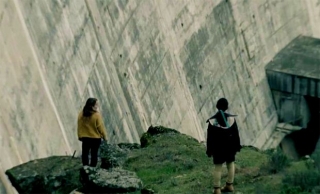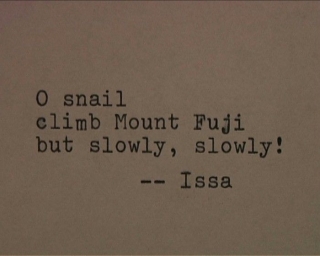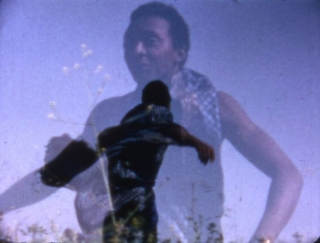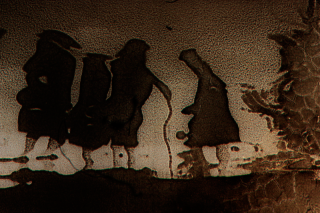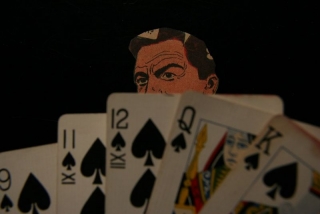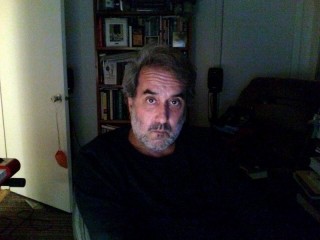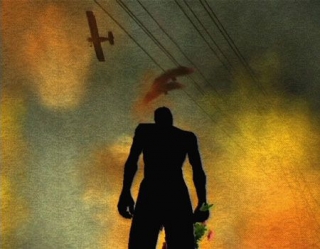Date: 22 October 2011 | Season: London Film Festival 2011 | Tags: London Film Festival
ALTERED STATES
Saturday 22 October 2011, at 2pm
London BFI Southbank NFT3
Ben Russell, Trypps #7 (Badlands), USA, 2010, 10 min
The mirror crack’d: As a young woman, high on LSD, looks toward the camera, the doors of perception swing open for both viewer and subject.
Mary Helena Clark, While You Were Sleeping, USA, 2010, 9 min
‘This is your life. It rides like a dream.’ (MHC)
Neil Beloufa, Sans Titre, France, 2010, 15 min
In a reconstruction of a villa occupied by terrorists during the Algerian War, onlookers speculate on the activities that took place.
Emily Wardill, The Pips, UK, 2011, 4 min
A gymnast performs, and everything begins to fall away …
Deborah Stratman, … These Blazeing Starrs!. USA, 2011, 14 min
Watch the skies! Throughout history, comets have heralded events of grave significance and change; today it is thought that they can reveal facts about the formation of the universe.
Michael Robinson, These Hammers Don’t Hurt Us, USA, 2010, 13 min
‘Tired of underworld and overworld alike, Isis escorts her favourite son on their final curtain call down the Nile, leaving a neon wake of shattered tombs and sparkling sarcophagi.’ (MR)
Also Screening: Thursday 27 October 2011, at 3:45pm, NFT3
PROGRAMME NOTES
ALTERED STATES
Saturday 22 October 2011, at 2pm
London BFI Southbank NFT3
ALTERED STATES
TRYPPS #7 (BADLANDS)
Ben Russell, USA, 2010, video, colour, sound, 10 min
Trypps #7 (Badlands) charts, through an intimate long-take, a young woman’s LSD trip in the Badlands National Park before descending into a psychedelic, formal abstraction of the expansive desert landscape. Concerned with notions of the romantic sublime, phenomenological experience, and secular spiritualism, the work continues Russell’s unique investigation into the possibilities of cinema as a site for transcendence. (Michael Green)
www.dimeshow.com
WHILE YOU WERE SLEEPING
Mary Helena Clark, USA, video, colour, sound, 2010, 9 min
‘This is your life. It rides like a dream.’ (Mary Helena Clark)
SANS TITRE
Neil Beloufa, France, 2010, video, colour, sound, 15 min
A cardboard decor and photographs reconstitute a luxury Californian-type villa in Algeria. Its inhabitants, neighbours and other protagonists imagine themselves there to explain why and how the latter was occupied by terrorists in order to hide whilst, paradoxically, it is entirely in glass. They even polished it clean so as to leave no traces. This improbable and irresolvable anecdote encourages the characters to invent images of an event given media coverage without the images nor the story and thus missing the main point. (Neil Beloufa)
THE PIPS
Emily Wardill, UK, 2011, video, b/w, silent, 4 min
Emily Wardill’s films encourage imagination as an unpredictable tool to surpass rational thought. The Pips explores movement and the materiality of it, the instigation of one and the duration of the other. Shot in black and white on 16mm, then transferred to a digital projection, The Pips focuses on British gymnastics champion, Francesca Jones. The film begins with a straight depiction of Jones’ routine; the patterns created by her ribbon baton trace her movements in the air. It is a reflection of her actions, imitating her and existing because of her. Near the end of the film, the gymnast’s body becomes stretched, elongated and distorted ultimately breaking into a series of mutant parts. Her face remains unfathomed and she gives no acknowledgement to her own decay. As Jones becomes still, her actions take on their own identity; their materiality deconstructed by Wardill’s emphasis on the physical replication of movement. The body and its motions become contained in the object, revealing an inherent plasticity in the gymnast’s performance. (Ian White)
… THESE BLAZEING STARRS!
Deborah Stratman, USA, 2011, 16mm, b/w, sound, 14 min
Since comets have been recorded, they’ve augured catastrophe, messiahs, upheaval and end times. A short film about these meteoric ice-cored fireballs and their historic ties to divination that combines imagery of 15th-18th century European broadsides with NASA Jet Propulsion Laboratory footage. … These Blazeing Starrs! juxtaposes a modern empirical desire to probe and measure against older methods, when we translated the sky to predict human folly. These days, comets are understood as time capsules harbouring elemental information about the formation of our solar system. We smash rockets into them to read spectral signatures. In a sense, they remain oracles – it’s just the manner of divining which has changed. (Deborah Stratman)
www.pythagorasfilm.com
THESE HAMMERS DON’T HURT US
Michael Robinson, USA, 2010, video, colour, sound, 13 min
Looking to a future beyond death, Michael Robinson’s These Hammers Don’t Hurt Us, one of the filmmaker’s most sophisticated found footage concoctions yet, combines Michael Jackson’s Remember the Time music video with footage of Elizabeth Taylor in Cleopatra and roughly a dozen other sources, creating for the late pop star a solemn passage into a bedazzled Egyptian afterlife tenderly ushered by his real-life confidante. (Genevieve Yue, Reverse Shot)
www.poisonberries.net
Back to top
Date: 22 October 2011 | Season: London Film Festival 2011 | Tags: London Film Festival
NATHANIEL DORSKY / BEN RIVERS
Saturday 22 October 2011, at 4pm
London BFI Southbank NFT3
Nathaniel Dorsky, Pastourelle, USA, 2010, 17 min
‘A pastourelle and an aubade are two different forms of courtship songs from the troubadour tradition. In this case, the film Pastourelle, a sister film to Aubade, is in the more tumultuous key of spring.’ (ND)
Nathaniel Dorsky, The Return, USA, 2011, 27 min
‘Like a memory already gone, this place of life.’ Dorsky has created a poetic form of cinema in which the screen becomes a site for reverie or transfiguration. In his most recent film, he seems to move towards a more abstract representation of light and being.
Ben Rivers, Sack Barrow, UK, 2011, 21 min
The march of time claims another casualty. Sack Barrow documents (and laments) the out-dated, but functioning, technology of a family owned electroplating factory in the weeks around its closure – its old ways now unsustainable in the modern world.
Also Screening: Tuesday 25 October 2011, at 8:45pm, NFT2
PROGRAMME NOTES
NATHANIEL DORSKY / BEN RIVERS
Saturday 22 October 2011, at 4pm
London BFI Southbank NFT3
NATHANIEL DORSKY / BEN RIVERS
PASTOURELLE
Nathaniel Dorsky, USA, 2010, 16mm, colour, silent, 17 min
Though silent, like all Dorsky films, Aubade and Pastourelle are named for types of love songs. His editing establishes tempo, and the shots, lyrical yet specific, thread through the film like melody lines. Music owes its universality to its abstract and primal qualities, which evoke intense emotion. Dorsky’s films operate on the viewer in this manner while still relying on recognizable images. By presenting music visually, he enlarges our sense of what songs and films alike can be. In particular Dorsky is drawn to the ways in which one thing becomes a conduit for transmitting another. Window surfaces are a recurring motif: through reflection, panes of glass contain images while remaining transparent, transforming the appearances of people or street scenes. There’s a shot in Pastourelle of vertical blinds shading a window; a strand pivots on its axis, animated by a draft. It’s mundane and magical simultaneously, an inconsequential detail that contains everything that is meaningful about seeing and being. The blind and the breeze share an interconnectedness you feel in your bones. An explication can’t do it justice. The wonder lies in the fact that it simply is. (Nicole Armour, Film Comment)
www.nathanieldorsky.net
THE RETURN
Nathaniel Dorsky, USA, 2011, 16mm, colour, silent, 27 min
Nathaniel Dorsky, the subject of numerous recent international retrospectives, is producing some of the most resplendent art of our time; his film work stems as much from painting and poetry as the outside world. With The Return, his latest film shot on 16mm and projected at silent speed (18fps), Dorsky delves deep into multiple (under)worlds, sometimes uncanny and surreal, reflected and refracted through various natural and man-made obfuscations like grids, glass, water and brush. From its wintry willow branches to wafting hand gestures in a café, The Return harbours a phantasmal feel, offering a sentient, sometimes dark rumination
on the mysteries that await us. It is, in Dorsky’s words, ‘Like a memory already gone, this place of life’. (Andréa Picard, Toronto International Film Festival)
www.nathanieldorsky.net
SACK BARROW
Ben Rivers, UK, 2011, 16mm, b/w & colour, sound, 21 min
Sack Barrow extends Rivers’ engagement with the marginal and overlooked. The factory is not a state-of-the-art capital producing business, but a site of anachronistically uncompetitive endeavour. The years of production are evident and the regimented clocking in and out of workers attests to the outmoded practices here, unlike the liberal job-sharing egalitarianism that government policy and public expectation impose elsewhere. The run-down architecture, the drips and crusty build-ups of toxic chemicals, the dangling wires, wizened faces and the general pragmatic clutter of the place come close to the patina of the unkempt shacks of earlier films. Sack Barrow is a hymn in a new register to the steadily disappearing textures of the past. (Sally O’Reilly)
www.benrivers.com
Back to top
Date: 22 October 2011 | Season: London Film Festival 2011 | Tags: London Film Festival
GABRIEL ABRANTES
Saturday 22 October 2011, at 7pm
London BFI Southbank NFT3
Gabriel Abrantes & Benjamin Crotty, Liberdade, Portugal-Angola, 2011, 16 min
Liberdade sketches episodes in the relationship between a domineering Chinese immigrant and her Angolan boyfriend with lavishly cinematic panache. Travelling through spectacular locations in and around Luanda, they navigate the complications of their burgeoning identities and the different cultures they represent.
Gabriel Abrantes & Daniel Schmidt, Palácios de Pena (Palaces of Pity), Portugal, 2011, 56 min
Gabriel Abrantes and his collaborators use the tropes of mainstream cinema to make works that are by turns comical, thought-provoking and transgressive. In a parable on guilt and oppression, which alludes to aspects of Portuguese colonial history, two cousins are potential heirs to their grandmother’s fortune. A new generation may be oblivious to the past, but inherits it nonetheless.
Gabriel Abrantes & Katie Widloski, Olympia I & II, Portugal-USA, 2008, 7 min
Mimicking the composition of Manet’s notorious painting, the artists play out two possible scenarios: between a prostitute and her gay brother, and between a wealthy transsexual and his devoted maid.
Also Screening: Tuesday 25 October 2011, at 1:15pm, NFT2
PROGRAMME NOTES
GABRIEL ABRANTES
Saturday 22 October 2011, at 7pm
London BFI Southbank NFT3
LIBERDADE
Gabriel Abrantes & Benjamin Crotty, Portugal-Angola, 2011, video, colour, sound, 16 min
Shot in Luanda and the surrounding area, with non-professional actors, Liberdade is a cross-cultural post-capitalist love story. The film follows two young lovers – an Angolan boy, Liberdade, and his Chinese girlfriend, Betty – as they navigate through the complications of their burgeoning identities. Traveling across the stunning urban and natural landscapes of Angola, from the Chinese karaoke at Shanghai Bahia to the ship graveyard at Santiago beach, Liberdade and Betty struggle to forge the yet uncreated consciousness of their race. (Gabriel Abrantes)
PALÁCIOS DE PENA (PALACES OF PITY)
Gabriel Abrantes & Daniel Schmidt, Portugal, 2011, video, colour, sound, 56 min
Palácios de pena is about a culturally inherited fear in Portugal, linked to political and social oppression during the Inquisition and Fascism. It revolves around two upper-middle class adolescent Portuguese girls, juxtaposing their budding identities to a trial condemning two Moorish homosexuals to burn at the stake. Their ailing grandmother gives them an awareness of their heritage through the mechanism of desire, describing a dream where she is a judge of the Inquisition. The grandmother’s and the girls’ guilt is complicated by their relationship, that of family and love. As they love each other, so does what they represent: ignorance and the will to violently oppress. (Gabriel Abrantes)
OLYMPIA I & II
Gabriel Abrantes & Katie Widloski, Portugal-USA, 2008, video, colour, sound, 7 min
1. A female professional sex worker is visited by her homosexual adolescent brother and his two dogs. He confronts her about her line of work after having played trivial pursuit with mother on the sun deck. He wouldn’t pay a dime for her disgusting breasts.
2. A transvestite professional sex worker from a middle class Texan family waits for customers while listening to Henry Gorecki and drinking mini Diet Coca-Cola. His maid, the ‘chocolate covered strawberry’, comforts him by rubbing his ‘soft batch’ and they begin making love. (Gabriel Abrantes)
www.mutualrespectproductions.blogspot.com
Back to top
Date: 22 October 2011 | Season: London Film Festival 2011 | Tags: London Film Festival
SLEEPLESS NIGHTS STORIES
Saturday 22 October 2011, at 9pm
London BFI Southbank NFT3
Jonas Mekas, Sleepless Nights Stories, USA, 2011, 114 min
Jonas Mekas’ opening confession that he suffers from insomnia will come as no surprise to anyone aware of his singular contribution to cinema. Over 50 years he has established and promoted a viable culture for truly independent and avant-garde filmmaking, and his recent acceptance by the art world has brought a long overdue wave of attention and success. Sleepless Nights Stories is the latest in the series of long-form diary films that Mekas has been making since his arrival in the USA in 1949. Eating, drinking, singing and dancing with friends, the tireless octogenarian is full of life and wonder, casually weaving together contemporary folk tales collected during travels across the globe. Marina Abramovic fantasizes about domesticity, Lee Stringer recounts an episode from his crack-addicted past, and the protagonist toasts the ‘working class voice’ of Amy Winehouse. Marina Abramovic, Björk, Harmony Korine and Patti Smith also appear. Treating significant and inconsequential moments with equal import, Mekas’ modern day saga presents the first episodes from his ambitious ‘1001 Nights’ project. (Mark Webber)
Also Screening: Tuesday 18 October 2011, at 9pm, VUE3
& Thursday 20 October 2011, at 7pm, BFI Studio
PROGRAMME NOTES
SLEEPLESS NIGHTS STORIES
Saturday 22 October 2011, at 9pm
London BFI Southbank NFT3
SLEEPLESS NIGHTS STORIES
Jonas Mekas, USA, 2011, video, colour, sound, 114 min
For two hours we stroll with Jonas Mekas through New York nights, through apartments, studios, backstage rooms, galleries, bars and clubs. We meet old acquaintances like Ken and Flo Jacobs, Yoko Ono, Patti Smith, Carolee Schneemann, Marina Abramovi?, Hans Ulrich Obrist, Pip Chodorov, friends, brothers and sisters, sons and daughters, and we also make many new acquaintances. The father of the diary film begins a film with the words ‘I can’t sleep’. Who hasn’t been in this situation? Sleepy and yet wide awake at the same time, you find yourself in the world of those exhausted from the day’s exertions; the drunk, the relaxed, the dancing, the brooding, the mourning, the pensive, the partiers. In this film Mekas dives into a time vacuum … and it becomes increasingly unclear whether we really did get up and go out, whether what we’re seeing are remnants of the day that we’re remembering, or remnants of films by one of the greatest avant-garde filmmakers whose life wrote film history. (Berlinale)
This film originated from my readings of the One Thousand and One Nights. But unlike the Arabian tales, my stories are all from real life, though at times they too wander into somewhere else, beyond the everyday routine reality. There are some twenty-five different stories in my movie. Their protagonists are all my good friends and I myself am an inseparable part of the stories. The storyteller of the Arabian Nights was also part of his or her tales. Some of the people in the movie you’ll recognize, some not. The fact that some of them you’ll recognize has no bearing on the stories: after all, we all recognize John Wayne or Annette Bening, but in their stories they are no longer the people we know. The subjects of the stories cover a wide range of emotions, geographies, personal anxieties, anecdotes. These are not very big stories, not for the Big Screen: these are all personal big stories … And yes, you’ll also find some provocations … But that’s me, one ‘me’ of many. The very question ‘What is a story?’ is a provocative question. (Jonas Mekas)
www.jonasmekasfilms.com
Back to top
Date: 23 October 2011 | Season: London Film Festival 2011 | Tags: London Film Festival
INTIMATE VISION: FILMS BY CHICK STRAND
Sunday 23 October 2011, at 2pm
London BFI Southbank NFT3
As one of the instigators of Canyon Cinema, Chick Strand (1931-2009) was at the heart of 1960s West Coast avant-garde. Her film work, comprising of found footage and personally photographed material, has been rarely seen in the UK and is presented now in newly preserved prints. Strand’s camera is almost continually in motion, catching details in kinetic close-up to convey celebrations of intimacy and the joys of living.
Chick Strand, Cartoon le Mousse, USA, 1979, 15 min
In her collage films, Strand uses the magic of editing to conjure surreal humour from the connections between disparate fragments.
Chick Strand, Mosori Monika, USA, 1970, 20 min
The impact of American missionaries on the Warao Indians in Venezuela is considered from the viewpoints of women from each side.
Chick Strand, Angel Blue Sweet Wings, USA, 1966, 3 min
A multi-layered cine-poem apropos life and vision.
Chick Strand, Loose Ends, USA, 1979, 25 min
Found footage is used to convey the effect of information overload, finding wit and pathos in the complicated synthesis of personal experience and media assault.
Chick Strand, Artificial Paradise, USA, 1986, 13 min
‘The anthropologist’s most human desire: the ultimate contact with the informant. The denial of intellectualism and the acceptance of the romantic heart, and a soul without innocence.’ (CS)
Chick Strand, Kristallnacht, USA, 1979, 7 min
‘Dedicated to the memory of Anne Frank, and the tenacity of the human spirit.’ (CS)
Also Screening: Thursday 27 October 2011, at 9pm, NFT3
PROGRAMME NOTES
INTIMATE VISION: FILMS BY CHICK STRAND
Sunday 23 October 2011, at 2pm
London BFI Southbank NFT3
For most of her filmmaking career, the integrity of Chick Strand’s vision lay aslant of prevailing fashions, so that only belatedly did the full significance of her radically pioneering work in ethnographic, documentary, feminist, and compilation filmmaking – and above all, in the innovation of a unique film language created across these modes – become clear. Though feminism and other currents of her times are woven through her films and though her powerful teaching presence sustained the ideals of underground film in several film schools in Los Angeles, hers was essentially a school of one. (David James, The Most Typical Avant-Garde)
CARTOON LE MOUSSE
Chick Strand, USA, 1979, 16mm, b/w, sound, 15 min
Chick Strand is a prolific and prodigiously gifted film artist who seems to break new ground with each new work. Her recent ‘found footage’ works, such as Cartoon le Mousse, are extraordinarily beautiful, moving, visionary pieces that push this genre into previously unexplored territory. If poetry is the art of making evocative connections between otherwise dissimilar phenomena, then Chick Strand is a great poet, for these films transcend their material to create a surreal and sublime universe beyond reason. (Gene Youngblood)
MOSORI MONIKA
Chick Strand, USA, 1970, 16mm, colour, sound, 20 min
An expressive documentary about women in the Third World. This is an ethnographic film about two cultures that have encountered one another. The Spanish Franciscan Missionaries went to Venezuela in 1945 to ‘civilize’ the Warao Indians, who live in the swamps on the Orinoco River Delta. Before the missionaries came, the Waraos lived in relative isolation and were little affected by the outside world. The relationship between the Indians and the missionaries is simple on the surface, but it is manifested in a complex change of techniques, values and lifestyle which have indelibly altered the Warao vision of life. The acculturation is presented from two viewpoints. A nun tells how the Indians lived when the missionaries arrived and what the nuns have done to ‘improve’ conditions, both spiritually and materially. An old Warao Indian woman tells what she feels has been the important experiences in her life. The two viewpoints are structured in counterpoint so that the deeper aspects of the juxtaposition of the modern culture over the old becomes apparent through the revelations of the two women. (Chick Strand)
ANGEL BLUE SWEET WINGS
Chick Strand, USA, 1966, 16mm, colour, sound, 3 min
An experimental film poem in celebration of life and visions. Techniques include live action, animation, montage and found images. (Chick Strand)
LOOSE ENDS
Chick Strand, USA, 1979, 16mm, b/w, sound, 25 min
Loose Ends is a collage film about the process of internalizing the information that bombards us through a combination of personal experience and media in all forms. Speeding through our senses in ever-increasing numbers and complicated mixtures of fantasy, dream and reality from both outside and in, these fragmented images of life, sometimes shared by all, sometimes isolated and obscure, but with common threads, lead us to a state of psychological entropy tending toward a uniform inertness … an insensitive uninvolvement in the human condition and our own humanity. (Chick Strand)
ARTIFICIAL PARADISE
Chick Strand, USA, 1986, 16mm, colour, sound, 13 min
Aztec romance and the dream of love. The anthropologist’s most human desire – the ultimate contact with the informant. The denial of intellectualism and the acceptance of the romantic heart, and a soul without innocence. (Chick Strand)
KRISTALLNACHT
Chick Strand, USA, 1979, 16mm, b/w, sound, 7 min
Dedicated to the memory of Anne Frank, and the tenacity of the human spirit. (Chick Strand)
Loose Ends was preserved by Pacific Film Archive, Berkeley. All other films preserved by Pacific Film Archive and Academy Film Archive, Los Angeles, with support from the National Film Preservation Foundation.
Back to top
Date: 23 October 2011 | Season: London Film Festival 2011 | Tags: London Film Festival
PHIL SOLOMON’S AMERICAN FALLS
Sunday 23 October 2011, at 4pm
London BFI Southbank NFT3
‘Should anyone imagine that the art of alchemy died with the Middle Ages, Phil Solomon’s American Falls testifies to the contrary: both to the possibilities of photographic and digital transformation and to the magical emanations of their fusion.’ (Tony Pipolo, Artforum)
Phil Solomon, American Falls, USA, 2010, 60 min
In his sublime 16mm films, Phil Solomon chemically alters photographic imagery to create a thick celluloid impasto that infuses footage with profound emotional resonance. For American Falls, Solomon rifles through a collective memory fashioned from both fact and fiction, mixing elements from newsreels, actualities and narrative films in a monumental retelling of American history which draws parallels with and reflects upon the current state of the nation. Houdini, Harold Lloyd, Keaton and King Kong commingle with presidents, gold-diggers, railroad barons and the civil rights movement. ‘My project is ultimately one of great hope, stemming from a life-long love for this American experiment of ours … but it is also necessitated by my deepest concern for its present and future directions.’ Originally conceived as a 360-degree installation around the walls of the Corcoran Gallery of Art’s rotunda, the work has been reconfigured for the cinema as a panoramic view in triptych, with surround sound mix by composer Wrick Wolff.
Screening with
Phil Solomon, What’s Out Tonight Is Lost, USA, 1983, 8 min
‘The film began in response to an evaporating relationship, but gradually seeped outward to anticipate other imminent disappearing acts: youth, family, friends, time … I wanted the tonal shifts of the film’s surface to act as a barometer of the changes in the emotional weather.’ (PS)
Preserved by the Academy Film Archive, Los Angeles.
Also Screening: Tuesday 25 October 2011, at 4pm, NFT3
Phil Solomon will present screenings of his earlier films at Tate Modern on 24 & 27 October.
PROGRAMME NOTES
PHIL SOLOMON’S AMERICAN FALLS
Sunday 23 October 2011, at 4pm
London BFI Southbank NFT3
PHIL SOLOMON’S AMERICAN FALLS
AMERICAN FALLS
Phil Solomon, USA, 2010, video, colour, sound, 60 min
Conception and Direction – Phil Solomon
Sound Design – Wrick Wolff & Phil Solomon
5.1 and Stereo Mixes – Wrick Wolff
Alchemy – Phil Solomon & Jessica Betz
Optical Printing – Phil Solomon & Jessie Marek
Technical Advisor – Christopher Osborn
Should anyone imagine that the art of alchemy died with the Middle Ages, Phil Solomon’s American Falls testifies to the contrary: both to the possibilities of photographic and digital transformation and to the magical emanations of their fusion. The work is epic in conception and form, with a surface texture that, as it refashions and transmutes archival footage from myriad sources, resembles something between a palimpsest of chemical and photographic strata and the impasto of a painter’s canvas. The incipient visions of Solomon’s previous labours in this style here burst forth, unleashed, with images from America’s collective unconscious.
Burnished bronze and pulsing forward through layers of idiosyncratic techniques, they flesh out a three-framed canvas with ‘monumental’ aspirations, sometimes invoking the nation’s war memorials. Images are conjured into transient visibility before dissolving back into the recesses of historical memory. This is as much about inviting instant recognition as it is about limiting exposure of the overfamiliar. Similarly, popular songs are gently deconstructed through the rhythmic protractions of an intricate sound design (co-created and mixed by Wrick Wolff) that freshens their nostalgic currency.
Opening with 1901 footage and a re-enactment of Annie Edson Taylor, the first person to survive going over Niagara Falls in a barrel, allusions to ‘falls’ pervade: of political and inspirational leaders (from Lincoln to FDR to JFK and King), and soldiers on battlefields (the American Revolution, the Civil War, both world wars, and Korea); from pratfalls of movie comics (Buster Keaton, Harold Lloyd, and Charlie Chaplin) to baseball heroes crippled by disease (Lou Gehrig). Disillusionment with America’s promise is palpable throughout. In one triptych, George Washington in the central panel is flanked by the text of the Declaration of Independence; but in another the Liberty Bell’s crack is visible in all three panels. Still later, the looming rule of capital, evoked by the credits of Erich von Stroheim’s Greed, needs only the central panel to dominate.
It is impossible to do justice here to the juxtapositions and permutations of these images, or to the aching beauty and emotional resonances of this work. Much of the latter derives from the sheer physiological spectacle of each marble or bronze tableau throbbing into life through Solomon’s midwifery. More than any other independent film or video I can think of from the past decade, American Falls invokes the spectre of a nation whose present unravelling is all too rooted in its history. How sad it is to realize that Solomon’s masterwork, painstakingly crafted over thousands of hours, cannot hope to reach as many people as the lamest television commercial. Anyone still touched by the poetic viability of the avant-garde should not miss this opportunity to see it. (Tony Pipolo, Artforum)
WHAT’S OUT TONIGHT IS LOST
Phil Solomon, USA, 1983, 16mm, silent, colour, 8 min
Adopting its title from a poem by Edna St. Vincent Millay, What’s Out Tonight Is Lost is an elegiac film sifting through the unrecoverable. The film is a reflecting pool where vision breaks up. The home we recognize is swallowed in the brume, the light barely penetrates; and the yellow school bus steals us away, delivering us into new clouds, embracing fear. The film has a surface of cracked porcelain and intaglio: the allergic childhood skin of cracks and bruises. This is a film of transubstantiations, the discorporation of human forms into embers. Air looms and blossoms into solidity and nearness … I hear it breathing. (Mark McElhatten)
What’s Out Tonight Is Lost was preserved by Academy Film Archive, Los Angeles.
Phil Solomon will introduce two different programmes of his earlier 16mm films at Tate Modern on Monday 24 & Thursday 27 October, 2011, from 7pm.
Back to top
Date: 23 October 2011 | Season: London Film Festival 2011 | Tags: London Film Festival
THE PETTIFOGGER
Sunday 23 October 2011, at 7pm
London BFI Southbank NFT3
Lewis Klahr, The Pettifogger, USA, 2011, 65 min
The first feature-length work by Lewis Klahr takes a unique approach to a familiar genre. Ostensibly a thriller that traces events in the life of an American gambler and con man circa 1963, The Pettifogger is described by the filmmaker as ‘an abstract crime film and, like many other crime films involving larceny, a sensorial exploration of the virulence of unfettered capitalism.’ Characters lifted from comic books move through an impressionistic landscape of textures, photographs and drawings, populating a story whose narrative is suggested but not strongly defined. Employing a range of iconography and appropriated audio to expand his signature style of collage animation, Klahr recycles symbols of popular culture to address themes of the loss of innocence and the irresistible allure of wealth.
Screening with
Lewis Klahr, April Snow, USA, 2010, 10 min
A love story about cars and girls, carried away by songs from the Shangri-La’s and The Boss.
Also Screening: Tuesday 25 October 2011, at 7pm, STUDIO
PROGRAMME NOTES
THE PETTIFOGGER
Sunday 23 October 2011, at 7pm
London BFI Southbank NFT3
APRIL SNOW
Lewis Klahr, USA, 2010, video, colour, sound, 10 min
Another ‘couplet’ from my ongoing Prolix Satori series. I thought up the juxtaposition of these two pop songs while creating a mix-tape back in 1988 but never thought I’d work with them as a film soundtrack. Back then the taboo in experimental film circles about using music was so strong it seemed permanent. (Lewis Klahr)
THE PETTIFOGGER
Lewis Klahr, USA, 2011, video, colour, sound, 65 min
pettifogger: 1560s, from petty; the second element possibly from obs. Du. focker, from Flem. Focken ‘to cheat,’ or from cognate M.E. fugger, from Fugger the renowned family of merchants and financiers of 15c.-16c. Augsburg. In German, Flemish and Dutch, the name became a word for ‘monopolist, rich man, usurer’. A ‘petty Fugger’ would mean one who on a small scale practices the dishonourable devices for gain popularly attributed to great financiers; it seems possible that the phrase ‘petty fogger of the law’, applied in this sense to some notorious person, may have caught the popular fancy. (The Etymology Dictionary)
A year in the life of an American gambler and con man circa 1963. A diaristic, first person montage full of glimpses, glances, decaying ephemera and elliptical narrative. An abstract crime film and, like many other crime films involving larceny, a sensorial exploration of the virulence of unfettered capitalism. An impressionistic collage film culled from a wide variety of image and sound sources that fully exploits the hieroglyphic essence of cutouts to ponder what appropriation and stealing have in common. Definitely the longest continuous film I’ve ever completed. (Lewis Klahr)
Back to top
Date: 23 October 2011 | Season: London Film Festival 2011 | Tags: London Film Festival
ON THE ROAD WITH ROBERT FENZ
Sunday 23 October 2011, at 9pm
London BFI Southbank NFT3
Robert Fenz’s films explore cultural diversity and the human condition with a keen eye reminiscent of his tutors Peter Hutton and James Benning. Mixing improvisation with luminous photography, he offers a poetic but political worldview. An associate of Robert Gardner’s Studio7Arts, Fenz has collaborated with musician Wadada Leo Smith and worked as cinematographer for Chantal Akerman.
Robert Fenz, The Sole of the Foot, USA, 2011, 34 min
Filmed in France, Israel and Cuba. ‘Borders (and all the politics attending the drawing of borders) exist to keep some people in (citizenship) and others out. This film is an attempt to capture the presence of people otherwise denied the political right to be at home in some place that is their home, where they have their roots, where they have their being.’ (RF)
Robert Fenz, Correspondence, USA, 2011, 30 min
For Correspondence, Fenz travelled to places where the pioneering ethnographic filmmaker Robert Gardner shot three of his best-known films – West Papua (Dead Birds), Ethiopia (Rivers of Sand) and India (Forest of Bliss). While documenting present conditions in these locations, Fenz also constructs an elegy for a form of image-making that is now in decline.
Also Screening: Monday 24 October 2011, at 2pm, NFT3
PROGRAMME NOTES
ON THE ROAD WITH ROBERT FENZ
Sunday 23 October 2011, at 9pm
London BFI Southbank NFT3
Robert Fenz’s films explore culture diversity and the human condition with a keen eye reminiscent of his tutors Peter Hutton and James Benning. Mixing improvisation with luminous photography, he offers a poetic but political worldview. An associate of Robert Gardner’s Studio7Arts, Fenz has also collaborated with musician Wadada Leo Smith and worked as cinematographer for Chantal Akerman. (Mark Webber)
THE SOLE OF THE FOOT
Robert Fenz, USA, 2011, 16mm, colour, sound, 34 min
Filmed in France, Israel and Cuba. ‘Borders (and all the politics attending the drawing of borders) exist to keep some people in (citizenship) and others out. This film is an attempt to capture the presence of people otherwise denied the political right to be at home in some place that is their home, where they have their roots, where they have their being.’ (Robert Fenz)
CORRESPONDENCE
Robert Fenz, USA, 2011, 16mm, b/w, silent, 30 min
Filmmaker Robert Fenz returned to the locations of three classic films made by the pioneering American ethnographic filmmaker Robert Gardner. Dead Birds (1964) was filmed in West Papua, Rivers of Sand (1974) was filmed in Ethiopia and Forest of Bliss (1986) was filmed in Benares, India. Correspondence is not a straightforward commentary on Gardners’s films; it is an elegy for a kind of image-making that is in the process of disappearing. (Robert Fenz)
Back to top
Date: 24 October 2011 | Season: London Film Festival 2011, Phil Solomon | Tags: London Film Festival
FEEL FLOWS: THE FILMS OF PHIL SOLOMON
Monday 24 & Thursday 27 October 2011
London Tate Modern
On his first visit to the UK, Phil Solomon presents two programmes of his alchemical film work. By treating the celluloid surface with a variety of substances and techniques, Solomon transforms images to construct an emotionally charged and deeply affecting cinema. Often elegiac in tone, his symphonic approach makes the personal profound.
This survey of Solomon’s 16mm films also features Rehearsals for Retirement, a machinima work from the digital series In Memoriam (for Mark LaPore), made with imagery drawn from the Grant Theft Auto videogames. Programme two includes Seasons…, a collaboration with Solomon’s colleague, friend and mentor Stan Brakhage.
“Although part of a long avant-garde tradition, Solomon makes films that look like no others I’ve seen. The conceit of the filmmaker as auteur has rarely been more appropriate or defensible – the liberating effect of Solomon’s work suggests a rather different realm: Film Meets Vision, Rejoice!” (Manohla Dargis, New York Times
PHIL SOLOMON: PROGRAMME 1: Mon 24 Oct 2011
PHIL SOLOMON: PROGRAMME 2: Thur 27 Oct 2011
Curated by Mark Webber and presented in association with The 55th BFI London Film Festival.
Phil Solomon will premiere “American Falls” at BFI Southbank on Sunday 23 October 2011.
Back to top
Date: 24 October 2011 | Season: London Film Festival 2011, Phil Solomon | Tags: London Film Festival
PHIL SOLOMON: PROGRAMME 1
Monday 24 October 2011, at 7pm
London Tate Modern
THE EXQUISITE HOUR
Phil Solomon, 1989/94, 16mm, colour, sound, 14 min
“… Partly a lullaby for the dying, partly a lament of the death of cinema … [it] is dedicated to the memory of my grandparents, Albert Solomon, who was a projectionist for Fox, and Rose Solomon, who took tickets at Lowe’s Paradise in the Bronx.” (Phil Solomon)
THE SNOWMAN
Phil Solomon, 1995, 16mm, colour, sound, 8 min
“A meditation on memory, burial and decay – a belated kaddish for my father.” (Phil Solomon)
CLEPSYDRA
Phil Solomon, 1992, 16mm, b/w, silent, 15 min
“Solomon has evolved his technique so that in his latest work (‘Clepsydra’ – ‘waterclock’) the textures are constantly changing and are often appropriate to each figure in metaphoric interplay with each figure’s gestural (symbolic) movement. He has, thus, created consonance with thought as destroyer/creator – a Kali-like aesthetic ‘There is a light at the end of the tunnel’ (Romantic); and it is a train coming straight at us: … (and, to balance such, perhaps, with a touch of Zen) … it is beautiful!” (Stan Brakhage)
PSALM III: “NIGHT OF THE MEEK”
Phil Solomon, 2002, 16mm, b/w, sound, 23 min
“It is Berlin, November 9, 1938, and, as the night air is shattered throughout the city, the Rabbi of Prague is summoned from a dark slumber, called upon once again to invoke the magic letters from the Great Book that will bring his creature made from earth back to life, in the hour of need. A kindertodenliede in black and silver on a night of gods and monsters.” (Phil Solomon)
REHEARSALS FOR RETIREMENT
Phil Solomon, 2007, video, colour, sound, 10 min
“Had I known the end would end in laughter / I tell my daughter it doesn’t matter.” (Phil Ochs)
Back to top


